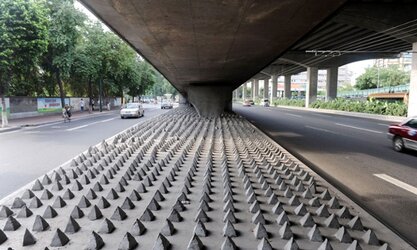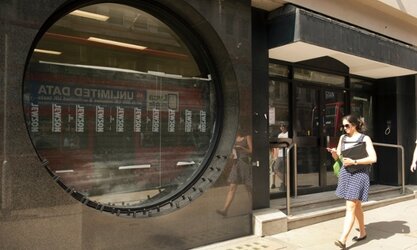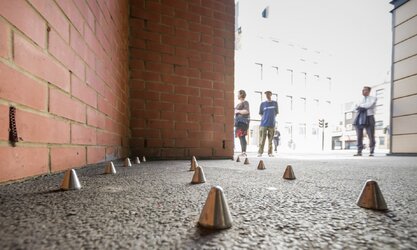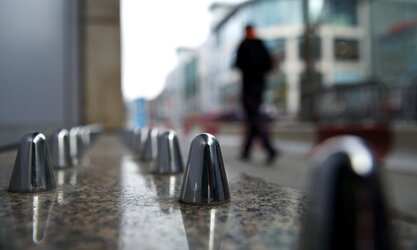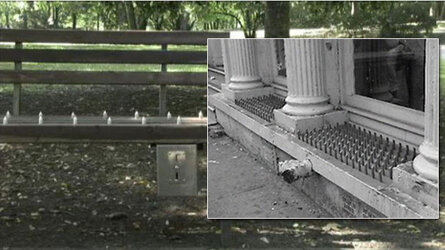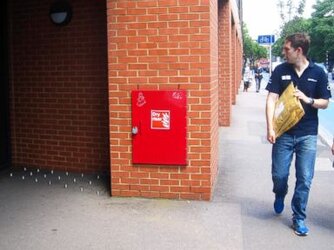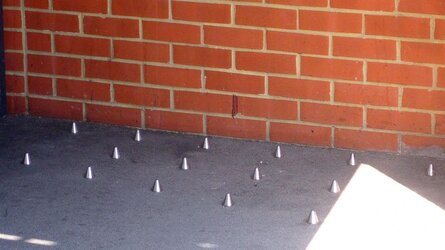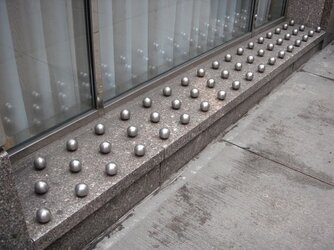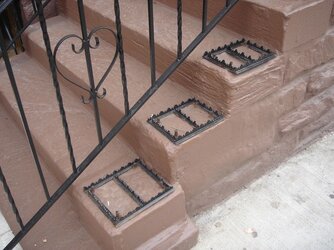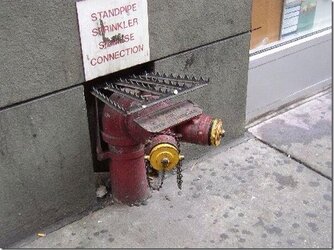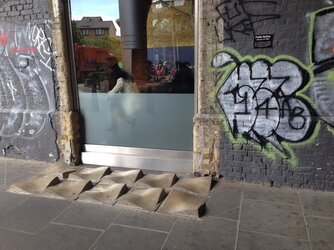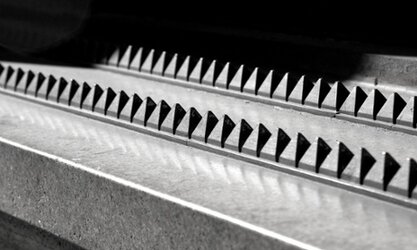Tude
Sometimes traveler is traveling.
Wow - I found this on another familiar site (thank you Rebecca) but seriously - I knew and have seen some of this stuff on some railings and ornamental areas where I live and thought they just didn't want people to disrupt their gardens and such, how sad am I to realize that there is more to it.
http://www.theguardian.com/society/...ty-undeen-and-makes-us-more-hostile?CMP=fb_gu
_____________
Anti-homeless spikes: ‘Sleeping rough opened my eyes to the city’s barbed cruelty’
The spikes installed outside Selfridges in Manchester are the latest front in the spread of ‘defensive architecture’. Is such open hostility towards the destitute making all our lives uglier?

Metal studs outside private flats on Southwark Bridge Road, London. Photograph: Guy Corbishley/Demotix/Corbis
Alex Andreou
Wednesday 18 February 2015 13.30 ESTLast modified on Wednesday 18 February 201519.05 EST
More than 100 homeless people are “living” in the terminals of Heathrow airport this winter, according to official figures – a new and shameful record. Crisis and the Joseph Rowntree Foundation have warned that homelessness in London is rising significantly faster than the nationwide average, and faster than official estimates. And yet, we don’t see as many people sleeping rough as in previous economic downturns. Have our cities become better at hiding poverty, or have we become more adept at not seeing it?
Last year, there was great public outcry against the use of “anti-homeless” spikesoutside a London residential complex, not far from where I live. Social media was set momentarily ablaze with indignation, a petition was signed, a sleep-in protest undertaken, Boris Johnson was incensed and within a few days they were removed. This week, however, it emerged that Selfridges had installed metal spikes outside one of its Manchester stores – apparently to “reduce litter and smoking … following customer complaints”. The phenomenon of “defensive” or “disciplinary” architecture, as it is known, remains pervasive.
From ubiquitous protrusions on window ledges to bus-shelter seats that pivot forward, from water sprinklers and loud muzak to hard tubular rests, from metal park benches with solid dividers to forests of pointed cement bollards under bridges, urban spaces are aggressively rejecting soft, human bodies.
We see these measures all the time within our urban environments, whether in London or Tokyo, but we fail to process their true intent. I hardly noticed them before I became homeless in 2009. An economic crisis, a death in the family, a sudden breakup and an even more sudden breakdown were all it took to go from a six-figure income to sleeping rough in the space of a year. It was only then that I started scanning my surroundings with the distinct purpose of finding shelter and the city’s barbed cruelty became clear.
I learned to love London Underground’s Circle line back then. To others it was just the rather inefficient yellow line on the tube network. To me – and many homeless people – it was a safe, dry, warm container, continually travelling sometimes above the surface, sometimes below, like a giant needle stitching London’s centre into place. Nobody harassed you or moved you on. You were allowed to take your poverty on tour. But engineering work put a stop to that.
Next was a bench in a smallish park just off Pentonville Road. An old, wooden bench, made concave and smooth by thousands of buttocks, underneath a sycamore with foliage so thick that only the most persistent rain could penetrate it. Sheltered and warm, perched as it was against a wall behind which a generator of some sort radiated heat, this was prime property. Then, one morning, it was gone. In its place stood a convex metal perch, with three solid armrests. I felt such loss that day.

FacebookTwitterPinterest
Hostile architecture on the former Coutts Bank, Fleet Stree, London. Photograph: Linda Nylind for the Guardian
“When you’re designed against, you know it,” says Ocean Howell, who teaches architectural history at the University of Oregon, speaking about anti-skateboarding designs. “Other people might not see it, but you will. The message is clear: you are not a member of the public, at least not of the public that is welcome here.” The same is true of all defensive architecture. The psychological effect is devastating.
There is a wider problem, too. These measures do not and cannot distinguish the “vagrant” posterior from others considered more deserving. When we make it impossible for the dispossessed to rest their weary bodies at a bus shelter, we also make it impossible for the elderly, for the infirm, for the pregnant woman who has had a dizzy spell. By making the city less accepting of the human frame, we make it less welcoming to all humans. By making our environment more hostile, we become more hostile within it.
Defensive architecture is revealing on a number of levels, because it is not the product of accident or thoughtlessness, but a thought process. It is a sort of unkindness that is considered, designed, approved, funded and made real with the explicit motive to exclude and harass. It reveals how corporate hygiene has overridden human considerations, especially in retail districts. It is a symptom of the clash of private and public, of necessity and property.
Pavement sprinklers have been installed by buildings as diverse as the famousStrand book store in New York, a fashion chain in Hamburg and government offices in Guangzhou. They spray the homeless intermittently, soaking them and their possessions. The assertion is clear: the public thoroughfare in front of a building, belongs to the building’s occupant, even when it is not being used.
Setha Low, a professor in environmental psychology, and urban geographer Neil Smith, in their book The Politics of Public Space, describe the phenomenon as a creeping encroachment that has “culminated in the multiple closures, erasures, inundations and transfigurations of public space at the behest of state and corporate strategies”. They contend that the very economic and political revolutions that freed people from autocratic monarchies also enshrined principles of private property at the expense of a long tradition of common land.
Sculptor Fabian Brunsing brought a satirical eye to the issue by creating the “pay bench”, an art installation of a park bench that retracts its metal spikes for a limited time when the prospective sitter feeds it a coin. Chinese officials, completely missing the joke, thought that this was a great idea and installed similar benches in Yantai Park of the Shangdong province.

FacebookTwitterPinterest
Concrete spikes under a road bridge in Guangzhou city, Guangdong, China. Photograph: Imaginechina/REX
The architecture of our cities is a powerful guide to behaviour, both directly and in its symbolism. One of the very first acts of the newly elected Syriza government in Greece was to remove the metal barriers between the Hellenic parliament and Syntagma Square. The effect on the centre of Athens of the removal of this barricade – which represented the strife of the last few years – was almost magical, as if an entire city breathed a sigh of relief. The symbolism of a government saying that they were a part of the people, rather than apart from the people, was understood by all.
Artist Nils Norman has been documenting the phenomenon of defensive architecture since the late 90s with thousands of photographs. This “vernacular of terror”, as he calls it, has its roots in leftover space or “gap sites”: plots that are too small to develop but large enough to encourage loitering. He sees the loss of public space as directly related to a loss of public life. “City space is quietly altered to maximimise its control and circulation,” he says. “Benches become bum-free, which in turn become ‘perches’, which are in turn removed. As city spaces become cleaner and more symbolically ‘safe’, defensive design becomes more abundant and paranoid.”
Recently, as I walked into my local bakery, a homeless man (whom I had seen a few times before) asked whether I could get him something to eat. When I asked Ruth – one of the young women who work behind the counter – to put a couple of pasties in a separate bag and explained why, her censure was severe: “He probably makes more money than you from begging, you know,” she said, bluntly.
He probably didn’t. Half his face was covered with sores. A blackened, gangrenous-looking toe protruded from a hole in his ancient shoe. His left hand looked mangled and was covered in dry blood from some recent accident or fight. I pointed this out. Ruth was unmoved by my protestations. “I don’t care,” she said. “They foul in the green opposite. They’re a menace. Animals.”
It’s precisely this viewpoint that defensive architecture upholds. That the destitute are a different species altogether; inferior and responsible for their demise. Like pigeons to be shooed away; urban foxes disturbing our slumber with their screams. “Shame on you,” jumped in Libby, the older lady who works at the bakery. “That is someone’s son you’re talking about.”
We curse the destitute for urinating in public spaces with no thought about how far the nearest free public toilet might be. We blame them for their poor hygiene without questioning the lack of public facilities for washing. It costs £5 to take a shower at King’s Cross station. Wilful misconceptions about homelessness abound. For instance, that shelters are plentiful and sleeping rough is a lifestyle choice. Free shelters, unless one belongs to a particularly vulnerable group, are actually extremely rare. Getting a bed often depends on a referral from a local agency, which, in turn, depends on being able to prove a local connection. For the majority of homeless people, who have usually graduated from a life as itinerant sofa-surfers, it is impossible to prove.
This tripartite pressure of an increasingly hostile built environment, huge reduction in state budgets, and a hardening attitude to poverty can be disastrous for people sleeping rough, both physically and psychologically. Fundamental misunderstanding of destitution is designed to exonerate the rest from responsibility and insulate them from perceiving risk. All of us are encouraged to spend future earnings through credit. For the spell to be effective, it is essential to be in a sort of denial about the possibility that such future earnings could dry up. Most of us are a couple of pay packets from being insolvent. We despise homeless people for bringing us face to face with that fact.
Poverty exists as a parallel, but separate, reality. City planners work very hard to keep it outside our field of vision. It is too miserable, too dispiriting, too painful to look at someone defecating in a park or sleeping in a doorway and think of him as “someone’s son”. It is easier to see him and ask only the unfathomably self-centred question: “How does his homelessness affect me?” So we cooperate with urban design and work very hard at not seeing, because we do not want to see. We tacitly agree to this apartheid.

Spikes installed outside Selfridges in Manchester. Photograph: Christopher Thomond for the Guardian.
A homeless man, Pawel Koseda, was found dead last year; bled out, impaled on the six-inch spikes of the metal fence that surrounds St Mary Abbots in Kensington, the Camerons’ chosen place of worship. He had high levels of alcohol in his blood and was wearing hospital pyjamas under his clothes. Koseda used to be a university lecturer in Poland. Ed Boord, who found the body, said that several people walked by and didn’t even notice. “It upset me that someone like that spends their life not being noticed,” he said, “and even in their last moments people still walk past.”
Crisis and the Joseph Rowntree Foundation’s research says that UK homeless numbers have increased by a third in the last five years. Benefit sanctions are cited as the main reason. In this context of depressed wages and soaring living costs, reduced services and lack of housing, we are facing a humanitarian disaster. The Red Cross is involved in food aid in the UK for the first time since the second world war. Can our response as a civilised society really be limited to moving people on from our doorsteps?
This, more than anything else, will determine our future as a species. Our ability to share will be key to our survival. The rough sleeper’s bad fortune is intricately connected to someone else’s good fortune. The person sleeping outside the expensive Bond Street boutique is part of the same nexus as the person inside spending £500 on a pair of socks.
Resources are scarce. Infinite wealth creation is a fairytale. Real wealth – land, food, water, fuel – has physical limitations. If some take more than they need, others go without. We obsessively focus on the external: carbon emissions, recycling, charity work, social security, saving the snow leopard – all of them excellent goals – while doggedly refusing to look inwards and make the adjustments that might allow us to coexist more equitably.
A ray of hope from Vancouver – benches that unfold into shelters and read “This is a bench” during the day, but light up to reveal “This is a bedroom” at night. Perhaps a small step on what David Harvey, author of Social Justice and the City, calls the “path from an urbanism based on exploitation to an urbanism appropriate for the human species”.
Defensive architecture acts as the airplane curtain that separates economy from business and business from first class, protecting those further forward from the envious eyes of those behind. It keeps poverty unseen and sanitises our shopping centres, concealing any guilt for over-consuming. It speaks volumes about our collective attitude to poverty in general and homelessness in particular. It is the aggregated, concrete, spiked expression of a lack of generosity of spirit.
Ironically, it doesn’t even achieve its basic goal of making us feel safer. There is no way of locking others out that doesn’t also lock us in. The narrower the arrow-slit, the larger outside dangers appear. Making our urban environment hostile breeds hardness and isolation. It makes life a little uglier for all of us.
http://www.theguardian.com/society/...ty-undeen-and-makes-us-more-hostile?CMP=fb_gu
_____________
Anti-homeless spikes: ‘Sleeping rough opened my eyes to the city’s barbed cruelty’
The spikes installed outside Selfridges in Manchester are the latest front in the spread of ‘defensive architecture’. Is such open hostility towards the destitute making all our lives uglier?
Metal studs outside private flats on Southwark Bridge Road, London. Photograph: Guy Corbishley/Demotix/Corbis
Alex Andreou
Wednesday 18 February 2015 13.30 ESTLast modified on Wednesday 18 February 201519.05 EST
More than 100 homeless people are “living” in the terminals of Heathrow airport this winter, according to official figures – a new and shameful record. Crisis and the Joseph Rowntree Foundation have warned that homelessness in London is rising significantly faster than the nationwide average, and faster than official estimates. And yet, we don’t see as many people sleeping rough as in previous economic downturns. Have our cities become better at hiding poverty, or have we become more adept at not seeing it?
Last year, there was great public outcry against the use of “anti-homeless” spikesoutside a London residential complex, not far from where I live. Social media was set momentarily ablaze with indignation, a petition was signed, a sleep-in protest undertaken, Boris Johnson was incensed and within a few days they were removed. This week, however, it emerged that Selfridges had installed metal spikes outside one of its Manchester stores – apparently to “reduce litter and smoking … following customer complaints”. The phenomenon of “defensive” or “disciplinary” architecture, as it is known, remains pervasive.
From ubiquitous protrusions on window ledges to bus-shelter seats that pivot forward, from water sprinklers and loud muzak to hard tubular rests, from metal park benches with solid dividers to forests of pointed cement bollards under bridges, urban spaces are aggressively rejecting soft, human bodies.
We see these measures all the time within our urban environments, whether in London or Tokyo, but we fail to process their true intent. I hardly noticed them before I became homeless in 2009. An economic crisis, a death in the family, a sudden breakup and an even more sudden breakdown were all it took to go from a six-figure income to sleeping rough in the space of a year. It was only then that I started scanning my surroundings with the distinct purpose of finding shelter and the city’s barbed cruelty became clear.
I learned to love London Underground’s Circle line back then. To others it was just the rather inefficient yellow line on the tube network. To me – and many homeless people – it was a safe, dry, warm container, continually travelling sometimes above the surface, sometimes below, like a giant needle stitching London’s centre into place. Nobody harassed you or moved you on. You were allowed to take your poverty on tour. But engineering work put a stop to that.
Next was a bench in a smallish park just off Pentonville Road. An old, wooden bench, made concave and smooth by thousands of buttocks, underneath a sycamore with foliage so thick that only the most persistent rain could penetrate it. Sheltered and warm, perched as it was against a wall behind which a generator of some sort radiated heat, this was prime property. Then, one morning, it was gone. In its place stood a convex metal perch, with three solid armrests. I felt such loss that day.
FacebookTwitterPinterest
Hostile architecture on the former Coutts Bank, Fleet Stree, London. Photograph: Linda Nylind for the Guardian
“When you’re designed against, you know it,” says Ocean Howell, who teaches architectural history at the University of Oregon, speaking about anti-skateboarding designs. “Other people might not see it, but you will. The message is clear: you are not a member of the public, at least not of the public that is welcome here.” The same is true of all defensive architecture. The psychological effect is devastating.
There is a wider problem, too. These measures do not and cannot distinguish the “vagrant” posterior from others considered more deserving. When we make it impossible for the dispossessed to rest their weary bodies at a bus shelter, we also make it impossible for the elderly, for the infirm, for the pregnant woman who has had a dizzy spell. By making the city less accepting of the human frame, we make it less welcoming to all humans. By making our environment more hostile, we become more hostile within it.
Defensive architecture is revealing on a number of levels, because it is not the product of accident or thoughtlessness, but a thought process. It is a sort of unkindness that is considered, designed, approved, funded and made real with the explicit motive to exclude and harass. It reveals how corporate hygiene has overridden human considerations, especially in retail districts. It is a symptom of the clash of private and public, of necessity and property.
Pavement sprinklers have been installed by buildings as diverse as the famousStrand book store in New York, a fashion chain in Hamburg and government offices in Guangzhou. They spray the homeless intermittently, soaking them and their possessions. The assertion is clear: the public thoroughfare in front of a building, belongs to the building’s occupant, even when it is not being used.
Setha Low, a professor in environmental psychology, and urban geographer Neil Smith, in their book The Politics of Public Space, describe the phenomenon as a creeping encroachment that has “culminated in the multiple closures, erasures, inundations and transfigurations of public space at the behest of state and corporate strategies”. They contend that the very economic and political revolutions that freed people from autocratic monarchies also enshrined principles of private property at the expense of a long tradition of common land.
Sculptor Fabian Brunsing brought a satirical eye to the issue by creating the “pay bench”, an art installation of a park bench that retracts its metal spikes for a limited time when the prospective sitter feeds it a coin. Chinese officials, completely missing the joke, thought that this was a great idea and installed similar benches in Yantai Park of the Shangdong province.
FacebookTwitterPinterest
Concrete spikes under a road bridge in Guangzhou city, Guangdong, China. Photograph: Imaginechina/REX
The architecture of our cities is a powerful guide to behaviour, both directly and in its symbolism. One of the very first acts of the newly elected Syriza government in Greece was to remove the metal barriers between the Hellenic parliament and Syntagma Square. The effect on the centre of Athens of the removal of this barricade – which represented the strife of the last few years – was almost magical, as if an entire city breathed a sigh of relief. The symbolism of a government saying that they were a part of the people, rather than apart from the people, was understood by all.
Artist Nils Norman has been documenting the phenomenon of defensive architecture since the late 90s with thousands of photographs. This “vernacular of terror”, as he calls it, has its roots in leftover space or “gap sites”: plots that are too small to develop but large enough to encourage loitering. He sees the loss of public space as directly related to a loss of public life. “City space is quietly altered to maximimise its control and circulation,” he says. “Benches become bum-free, which in turn become ‘perches’, which are in turn removed. As city spaces become cleaner and more symbolically ‘safe’, defensive design becomes more abundant and paranoid.”
Recently, as I walked into my local bakery, a homeless man (whom I had seen a few times before) asked whether I could get him something to eat. When I asked Ruth – one of the young women who work behind the counter – to put a couple of pasties in a separate bag and explained why, her censure was severe: “He probably makes more money than you from begging, you know,” she said, bluntly.
He probably didn’t. Half his face was covered with sores. A blackened, gangrenous-looking toe protruded from a hole in his ancient shoe. His left hand looked mangled and was covered in dry blood from some recent accident or fight. I pointed this out. Ruth was unmoved by my protestations. “I don’t care,” she said. “They foul in the green opposite. They’re a menace. Animals.”
It’s precisely this viewpoint that defensive architecture upholds. That the destitute are a different species altogether; inferior and responsible for their demise. Like pigeons to be shooed away; urban foxes disturbing our slumber with their screams. “Shame on you,” jumped in Libby, the older lady who works at the bakery. “That is someone’s son you’re talking about.”
We curse the destitute for urinating in public spaces with no thought about how far the nearest free public toilet might be. We blame them for their poor hygiene without questioning the lack of public facilities for washing. It costs £5 to take a shower at King’s Cross station. Wilful misconceptions about homelessness abound. For instance, that shelters are plentiful and sleeping rough is a lifestyle choice. Free shelters, unless one belongs to a particularly vulnerable group, are actually extremely rare. Getting a bed often depends on a referral from a local agency, which, in turn, depends on being able to prove a local connection. For the majority of homeless people, who have usually graduated from a life as itinerant sofa-surfers, it is impossible to prove.
This tripartite pressure of an increasingly hostile built environment, huge reduction in state budgets, and a hardening attitude to poverty can be disastrous for people sleeping rough, both physically and psychologically. Fundamental misunderstanding of destitution is designed to exonerate the rest from responsibility and insulate them from perceiving risk. All of us are encouraged to spend future earnings through credit. For the spell to be effective, it is essential to be in a sort of denial about the possibility that such future earnings could dry up. Most of us are a couple of pay packets from being insolvent. We despise homeless people for bringing us face to face with that fact.
Poverty exists as a parallel, but separate, reality. City planners work very hard to keep it outside our field of vision. It is too miserable, too dispiriting, too painful to look at someone defecating in a park or sleeping in a doorway and think of him as “someone’s son”. It is easier to see him and ask only the unfathomably self-centred question: “How does his homelessness affect me?” So we cooperate with urban design and work very hard at not seeing, because we do not want to see. We tacitly agree to this apartheid.
Spikes installed outside Selfridges in Manchester. Photograph: Christopher Thomond for the Guardian.
A homeless man, Pawel Koseda, was found dead last year; bled out, impaled on the six-inch spikes of the metal fence that surrounds St Mary Abbots in Kensington, the Camerons’ chosen place of worship. He had high levels of alcohol in his blood and was wearing hospital pyjamas under his clothes. Koseda used to be a university lecturer in Poland. Ed Boord, who found the body, said that several people walked by and didn’t even notice. “It upset me that someone like that spends their life not being noticed,” he said, “and even in their last moments people still walk past.”
Crisis and the Joseph Rowntree Foundation’s research says that UK homeless numbers have increased by a third in the last five years. Benefit sanctions are cited as the main reason. In this context of depressed wages and soaring living costs, reduced services and lack of housing, we are facing a humanitarian disaster. The Red Cross is involved in food aid in the UK for the first time since the second world war. Can our response as a civilised society really be limited to moving people on from our doorsteps?
This, more than anything else, will determine our future as a species. Our ability to share will be key to our survival. The rough sleeper’s bad fortune is intricately connected to someone else’s good fortune. The person sleeping outside the expensive Bond Street boutique is part of the same nexus as the person inside spending £500 on a pair of socks.
Resources are scarce. Infinite wealth creation is a fairytale. Real wealth – land, food, water, fuel – has physical limitations. If some take more than they need, others go without. We obsessively focus on the external: carbon emissions, recycling, charity work, social security, saving the snow leopard – all of them excellent goals – while doggedly refusing to look inwards and make the adjustments that might allow us to coexist more equitably.
A ray of hope from Vancouver – benches that unfold into shelters and read “This is a bench” during the day, but light up to reveal “This is a bedroom” at night. Perhaps a small step on what David Harvey, author of Social Justice and the City, calls the “path from an urbanism based on exploitation to an urbanism appropriate for the human species”.
Defensive architecture acts as the airplane curtain that separates economy from business and business from first class, protecting those further forward from the envious eyes of those behind. It keeps poverty unseen and sanitises our shopping centres, concealing any guilt for over-consuming. It speaks volumes about our collective attitude to poverty in general and homelessness in particular. It is the aggregated, concrete, spiked expression of a lack of generosity of spirit.
Ironically, it doesn’t even achieve its basic goal of making us feel safer. There is no way of locking others out that doesn’t also lock us in. The narrower the arrow-slit, the larger outside dangers appear. Making our urban environment hostile breeds hardness and isolation. It makes life a little uglier for all of us.


